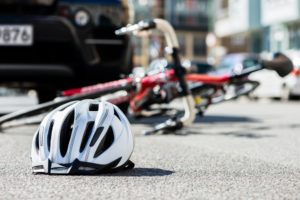Biking offers a great way to get out of the house, exercise, and use an eco-friendly mode of transportation. Biking increased substantially during the pandemic as many people looked for new ways to get active or explored activities that kept them outside rather than being around other people. Unfortunately, that may not offer the safe, comfortable experience many people hope for when they hop on their bikes.
Read on to learn more about how our bicycle injury attorneys help when you are in an accident.
The Rise in Bike Accidents
Increasingly, cyclists have seen higher deaths and higher accident rates out on the road. Eight hundred or more people die in bicycle-related accidents each year. That number, however, has risen in recent years, with more people dying because of bicycle accidents with cars. In some cases, deteriorating conditions on the road and a lack of proper bicycle infrastructure contribute to these devastating collisions.
Increasingly Dangerous Conditions on the Roads: The Risk to Cyclists

According to experts, the increased risk to cyclists occurs, at least partly, due to poor infrastructure and road dangers. On most streets, the top priority remains moving vehicles through these areas as quickly and smoothly as possible. Unfortunately, that may mean a lack of infrastructure to help cyclists safely travel across those same roads. Even though they have the same rights as drivers, cyclists struggle with potential dangers.
Lack of Adequate Bike Lanes and Infrastructure
Bike trails offer a great chance for cyclists to get out and explore green areas around their homes. However, they may not provide the freedom for cyclists to get to and from work, run errands, or use their bikes for transportation. For that, bikers may need to use the same roads used by vehicle traffic.
Unfortunately, many American cities lack adequate bike infrastructure. Many bikers find it difficult to get around the city without resorting to riding on the road. They may find themselves stuck, with no bike lanes to help carry them to their destinations.
On the road, cyclists may encounter several potential problems. They have to follow the same road rules drivers must follow, including obeying traffic signals. In many states, cyclists cannot legally ride on the sidewalk. This maintains a safe space for pedestrians.
They may even have the bicycle confiscated for riding on the sidewalk. However, cyclists generally travel at a much slower rate of speed than vehicle traffic on the roads. That means cyclists may have a tough time keeping up with the flow of traffic, which can cause immense frustration for drivers.
Bike lanes serve as a safe place for cyclists to travel. Since they have their lane, they can more easily navigate the streets without potentially getting in the way of vehicle drivers. Increased biking infrastructure, including more overall availability of bike trails where vehicles cannot travel, can also help make streets safer for cyclists since they will need to spend less time on the road.
Lack of Respect from Drivers
While cyclists generally have the same rights on the road as drivers, that does not necessarily mean that drivers will offer them that respect or allow them the freedom to travel as they need to. Often, drivers fail to respect bike lanes. They may encroach on those lanes to give themselves more room to turn or use those lanes to dodge traffic.
Many drivers will also fail to look adequately to determine whether a cyclist has already used those lanes, which may increase the risk of a collision. Drivers may also park in bike lanes, meaning cyclists can no longer safely move through them.
Furthermore, when drivers must share the road with cyclists, they may fail to use adequate precautions around them. Drivers may quickly become frustrated with sharing the road with a slower-moving cyclist since that cyclist may slow down traffic flow or create the perception of a block in the street. As a result, some drivers may attempt to speed around cyclists, pass them too closely, or otherwise ignore safety rules that could help protect cyclists as they ride.
Poor Driver Education Regarding Cyclists
Many drivers do not know how to share the road safely with a cyclist. They may quickly grow frustrated by a cyclist on the street, slowing down traffic flow but not knowing how to pass safely. For example, most states’ laws require at least three feet of separation between a vehicle and a bicycle.
Many drivers, however, may assume that they can treat bicycles like passenger vehicles or, in a worst-case scenario, that they do not need to leave any extra room for cyclists due to their greater overall maneuverability. That lack of space can substantially increase the risk of accidents.
Drivers may also lack information about how much time cyclists spend on the road and how to look out for them. Most of the time, drivers get in the habit of looking for large, passenger vehicle-sized objects in and around the road. They may not, however, take the extra time needed to look for the visual patterns created by cyclists and pedestrians, which may make them harder to spot. Passenger vehicle drivers who do not receive further warnings and take the time to look for cyclists may have a greater risk of causing a collision.
Lack of Barriers
Painted lines designating bike lanes can offer guidance about where cyclists can safely ride. However, those lines do little to prevent drivers from encroaching on those lanes. All too often, drivers will take advantage of what they see as empty or “free” space to cut over those lines, placing cyclists in danger.
Concrete curbs and barriers can go a long way toward providing further protection for cyclists. Cars generally struggle to get past concrete curbs and barriers, and drivers may prove less likely to engage in dangerous maneuvers when they know they may also cause serious damage to their vehicles. However, most areas lack these barriers, so cyclists also lack that protection. In places with barriers, they may offer only a brief bump in the road, which can cause drivers to think that they will not face substantial damage to their vehicles if they cross over them, making them less effective for cyclist safety.
Inadequate Off-Street Trails
Off-street trails can go a long way toward providing a safer location for cyclists. These trails have no vehicles on them, so cyclists can more safely use them to get around. Many cities have moved toward adding more bike trails and infrastructure to make it easier for cyclists to travel.
Unfortunately, they may not provide enough bike trails and support for cyclists to get around fully. Furthermore, while some may have green spaces for cyclists to use for leisure, these green spaces may not connect to places cyclists most need to visit, making them useless for getting around.
Poor Signaling
Most traffic signals exist primarily to ensure that vehicles do not end up involved in collisions with one another. Where infrastructure exists to support non-vehicle road users, it generally provides safe passage for pedestrians. Cyclists often have to use the same traffic signals as motor vehicle drivers.
Unfortunately for those cyclists, that may mean they cannot move safely around the vehicles that share the road. Lack of signals and signage may also mean that drivers do not realize that they have to share the road with cyclists, which means that drivers may fail to look out for them.
Speeding Through Neighborhoods
When kids head out to ride their bikes, they often do not think twice about riding in the street. They may use their bikes to get to their destinations, including heading off to a friend’s house, running down the block to pick something up from their favorite corner store, or riding back and forth in the street.
In many cases, those who live in these neighborhoods know they need to slow down to avoid an accident with children on the road. Unfortunately, some people may cut through these neighborhoods or rush through them without noting the potential presence of children, which can lead to devastating bicycle accidents.
Lack of Enforcement
All too often, when drivers misuse cycling lanes or fail to allow adequate room for cyclists, as long as an accident does not occur, nothing happens to the driver. In many cases, law enforcement officers may not have adequate time to respond before a driver disappears, even if they see the dangerous action.
Officers may also ignore risky behavior like entering bicycle lanes when a cyclist does not occupy those lanes since the transgression did not cause or risk an immediate accident. That lack of enforcement can cause severe problems since it helps reinforce these dangerous behaviors for cyclists.
Law enforcement officials must act to enforce the law concerning cyclists just like they do for pedestrians and vehicle drivers, or they may quickly discover that drivers ignore these regulations.
After a Bicycle Accident: How to Protect Yourself
Unfortunately, while many politicians continue to work to improve cycling infrastructure, it may still take time to see overall improvements.
If you do suffer injuries in a bicycle accident, you may need to take steps to protect yourself financially and physically.
- Report the accident to the police.
- Have a doctor look over your injuries. Even if you do not think you sustained severe injuries in the accident, you may want to have a doctor fully evaluate you. Sometimes, you may not immediately recognize the extent of your injuries, especially if adrenaline takes over.
- Keep a record of your medical needs and any instructions given by your medical care provider. Follow those instructions carefully to maximize your odds of making a full recovery. If you ignore the instructions issued by a medical provider, the insurance company that covers the liable driver could claim that you worsened your injuries, which could, in turn, prevent you from collecting the compensation you deserve.
- Get a copy of the accident report. Look over it and ensure that it contains accurate information about the accident’s time, date, and location. Remember that precise reporting about where an accident occurs can also help improve overall biking infrastructure in your city since legislators will more likely look at high-incident areas first.
- Contact a lawyer for help filing an injury claim related to your bicycle accident. By working with a lawyer, you can learn more about how much compensation you can expect for your bicycle accident injuries and how to proceed with your claim.
- Let your lawyer take care of dealing with the insurance company for you. When you deal with the insurance company alone, the insurance company can make it difficult for you to get the full compensation you deserve. The company may take your claim much more seriously when dealing with a lawyer.
- Keep a journal that lays out the details of your recovery. Note important dates, including follow-up procedures and other challenges you may face while recovering. Later, you can refer to that journal for vital information that can help shape your bicycle accident claim.
Dealing with the aftermath of a bicycle accident can prove incredibly stressful. Doing it alone may leave you scrambling to figure out what to do next and how to protect yourself. A lawyer, however, can help you navigate the claim process. Contact a bicycle accident attorney to learn more.
